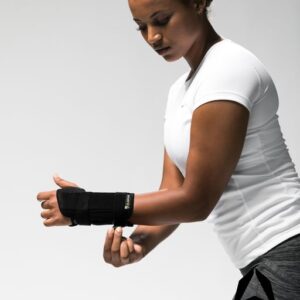



Living a full life brings joy and peace of mind, but too much physical activity can sometimes lead to injuries, broken bones, or wounds, even making you sick. Thankfully, in our modern age, there are medical supports that can help ease the pain and speed up recovery. Let’s talk about the difference between orthopedic wrist braces and splints to understand how they can assist in healing.
What is a splint and a brace?
A splint or brace serves as a supportive device for holding a body part in place, especially following an injury or surgery.
Although the terms “brace” and “splint” are often used interchangeably, there’s a general distinction in their purposes. Typically, a brace is designed to provide support to an injured area, offering stability and reinforcement. On the other hand, a splint is frequently used to immobilize or restrict movement in an injured body part. It’s worth noting that a splint is sometimes referred to as an orthosis.
So, when you hear “brace,” think about added support for a weakened or injured region, while “splint” implies limiting movement to aid in the healing process. Both play essential roles in recovery by providing the necessary assistance to the body part as it heals, helping to minimize further damage and promote a speedier recovery.
In hand therapy, we use two kinds of supports. One is a “splint,” which is a special support made just for you from hard plastic. For example, if you break your thumb, a hand therapist might make a splint molded to fit your thumb and keep the bones still while they heal.
The other type is a “brace,” which is something you can buy without it being made just for you. A hand therapist might suggest a brace, like one to help with pain in the joint at the bottom of your thumb if you have osteoarthritis. It gives support but isn’t custom-made for your hand.
Wrist Brace or Wrist Splint?
Wrist and hand splints are like special helpers for your joints and soft tissues. They’re used when your joints and soft tissues are in pain, swollen, or not very strong, like tendons and ligaments. The goal is to make sure your wrist and hands are in the right position.
There are four types:
1. Resting Splints: These give a break to your wrist and hand joints, allowing them to rest and recover.
2. Supportive Splints: These help your hands do different tasks by providing extra support.
3. Immobilizing Splints: These keep your bones or soft tissues still to help them heal after an injury.
4. Mobility Splints: They help stiff joints and soft tissues move better, increasing flexibility.
So, these splints are like buddies that help your hands and wrists feel better and work the way they should.
Resting splints or braces
Wearing a splint or brace can be a great way to support your joints and ease pain and inflammation. Take, for instance, a wrist support used for conditions like carpal tunnel syndrome. This splint or brace keeps your wrist straight, reducing pressure on the median nerve in the carpal tunnel.
A resting splint, in particular, aims to:
*Reduce Pain: It helps in lowering wrist and hand pain.
*Provide Support: By keeping your wrist and hand in the correct position, it offers support.
*Alleviate Swelling and Stiffness: This type of splint assists in reducing swelling and morning stiffness.
You might wear your resting splint:
*Overnight or Occasionally During the Day: Especially when you’re resting.
*During Painful Joints or Flare-Ups: Offering relief during more challenging times.
*As Advised by Your Therapist: Following their guidance for the best results.
Think of it as giving your wrist and hand a helpful break, promoting comfort and aiding in managing conditions like carpal tunnel syndrome.
Working splints or braces
Using a splint can provide valuable support for your wrist and hand joints while you go about your daily tasks. This extra support can make these activities less painful. For instance, a finger splint is crafted to support and ease stress on an arthritic joint.
Consider a working splint for tasks like holding a fishing rod:
*Purpose: It supports your wrist or finger during activities that might normally be painful.
*Ease of Tasks: The splint is designed to make daily jobs easier to manage.
*Increased Grip Strength: It helps boost your ability to grip things.
*Protection and Support: Provides added protection and support for your wrist or finger.
*Pain Reduction or Prevention: Aims to reduce or prevent pain in your wrist or finger.
You might choose to wear your working splint:
*During Painful Activities: Especially when certain activities cause you pain.
*When Swelling Occurs: If your wrist or finger is swollen.
*When Feeling Weak: If your wrist or finger feels weak.
*During Increased Discomfort: When you’re experiencing more discomfort than usual.
*As Advised by Your Therapist: Following the guidance of your therapist for the best results.
In essence, a working splint acts as a helpful companion during activities, supporting your hands and wrists to make tasks more manageable and less painful.
Splints or braces used for immobilization
This play a crucial role in treating healing bones or specific soft tissue injuries. Their primary function is to prevent unwanted motion that could interfere with the healing process. Typically, these splints are worn continuously and may only be removed for hygiene purposes or to perform specific exercises as directed by medical professionals. The constant use of splints or braces ensures that the injured area remains stable and undisturbed, promoting effective healing and minimizing the risk of further damage.
(ARYSE® PURESPEED® SPRAINED WRIST WRAP)
Mobility splints
Certain splints are designed to stretch tight tissues, with some meant for continuous wear, like those enhancing finger straightening. Others are intended for specific durations during the day, like those improving finger bending.
Wearing splint or brace
Sometimes, you might wear more than one splint, like having different pairs of glasses for different activities. For instance, during the day when you’re more active, you may use a light splint that gives support without limiting your movement. At night, a firmer splint is often worn to restrict motion, allowing your muscles and joints to rest, which can help reduce pain and inflammation. For conditions like carpal tunnel syndrome, some people wear a supportive splint during the day and a brace while sleeping to give tendons and nerves a chance to rest.
How can I determine the type of wrist splint/ wrist brace that is suitable for me?
A therapist can assist you in figuring out if a splint or brace would be helpful for your situation. If necessary, they can create a custom splint tailored specifically to your needs. While some braces are sold online or in pharmacies, it’s not advisable to purchase them without guidance from your doctor or therapist. This ensures that the brace is suitable and effective for your unique circumstances. It’s also important not to borrow or share splints with others, as they may not be designed to meet your specific needs.
Looking for a brace? Look no further! At Daphco Medical Equipment, we have different types of braces to help ease your pain and support your injury. Explore our store to find the right one for you. If you’re covered by Medicare, fill out this form, and we’ll give you a call to provide more info on getting a brace covered by your insurance.
Search Articles
Latest Articles
28th Feb, 24
23rd Feb, 24
20th Feb, 24
15th Feb, 24
13th Feb, 24



 888-616-4156
888-616-4156 






 28th Feb, 24
28th Feb, 24 


